
Begonia is a genus of perennial flowering plants in the family Begoniaceae. The genus contains more than 2,000 different plant species. The Begonias are native to moist subtropical and tropical climates. Some species are commonly grown indoors as ornamental houseplants in cooler climates. In cooler climates some species are cultivated outside in summertime for their bright colorful flowers, which have sepals but no petals.

Petrosaviaceae is a family of flowering plants belonging to a monotypic order, Petrosaviales. Petrosaviales are monocots, and are grouped within the lilioid monocots. Petrosaviales is a very small order composed of one family, two genera and four species accepted in 2016. Some species are photosynthetic (Japonolirion) and others are rare, leafless, chlorophyllous, mycoheterotrophic plants (Petrosavia). The family is found in low-light montane rainforests in Japan, China, Southeast Asia and Borneo. They are characterised by having bracteate racemes, pedicellate flowers, six persistent tepals, septal nectaries, three almost-distinct carpels, simultaneous microsporogenesis, monosulcate pollen, and follicular fruit.

Begoniaceae is a family of flowering plants with two genera and about 2040 species occurring in the subtropics and tropics of both the New World and Old World. All but one of the species are in the genus Begonia. There have been many recent discoveries of species in the genus Begonia, such as Begonia truncatifolia which is endemic to San Vincente, Palawan. B. truncatifolia is smaller in size than other species of the genus Begonia and this new species is proposed Critically Endangered by standards set by the IUCN. The only other genus in the family, Hillebrandia, is endemic to the Hawaiian Islands and has a single species. Phylogenetic work supports Hillebrandia as the sister taxon to the rest of the family. The genus Symbegonia was reduced to a section of Begonia in 2003, as molecular phylogenies had shown it to be derived from within that genus. Members of the genus Begonia are well-known and popular houseplants.
Begonia cavaleriei is a species of plant in the family Begoniaceae. It is endemic to China. It grows on limestone rocks.
Begonia dentatobracteata is a species of flowering plant in the family Begoniaceae. It is a tuberous geophyte endemic to western Yunnan province in south-central China.
Begonia hainanensis is a species of plant in the family Begoniaceae. It is endemic to China. It grows in forests and on mossy rocks.
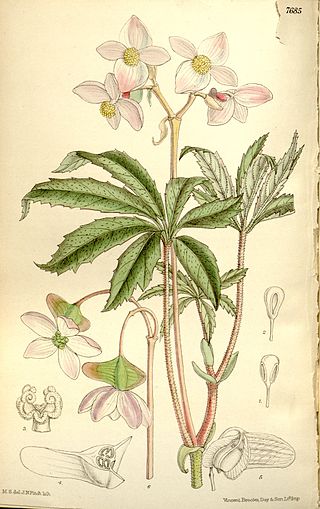
Begonia hemsleyana is a species of plant in the family Begoniaceae. It is a rhizomatous geophyte native to southwestern Guangxi and southeastern Yunnan in southern China, and to Laos, Myanmar, and Vietnam in northern Indochina.

Dicranopteris (forkedfern) is a genus of tropical ferns of the family Gleicheniaceae. There are about 20 described species.

Begonia palmata is a species of plant in the genus Begonia of the family Begoniaceae. It is a small herb of height 20–90 cm tall. It is found in moist places, next to streams or under the shade. It is found in many parts of Asia, including eastern Himalayas.
Begonia adamsensis is an endemic species of Begonia discovered in Adams, Ilocos Norte province, Luzon, Philippines occurring at an altitude of 308 m above sea level. The species broad-based leaves that are peltate, with a glabrous peduncle, an acuminate tip and nearly entire margin, resembled that of Begonia hernandioides. However, there are differences, in that B. hernandioides had red-colored stipule that is broadly ovate, the petiole and abaxial lamina is pubescent, and the peltate leaves are elliptic.
The Philippine Taxonomic Initiative (PTI) is a private Philippine research institute and non-profit organization founded in 2018, located in the Philippines.

Begonia longiciliata is a species of flowering plant in the family Begoniaceae, found in Laos and Vietnam, and Yunnan, Guizhou, Guangxi provinces of China. It is popular in cultivation.
Begonia tenuifolia is a species of flowering plant in the family Begoniaceae, native to Sumatra, Java, and the Lesser Sunda Islands. A tuberous geophyte of the seasonally dry tropics, it has variable leaf patterning and coloration. The leaves of young plants are round, with mature plants having narrow, ovate leaves. Individuals can reach 25 cm (10 in), but some have been observed to flower when only 2 cm (0.8 in) tall. The seeds are dispersed by a splash cup structure.
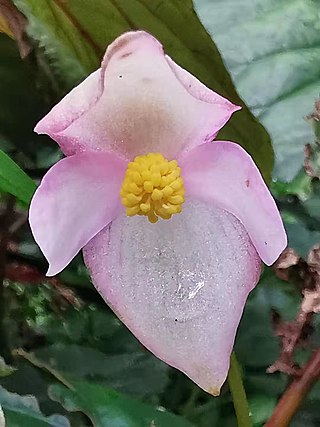
Begonia chitoensis, the hardy Taiwan begonia, is a species of flowering plant in the family Begoniaceae, native to central and northern Taiwan. It is found growing in forests at elevations from 400 to 2,200 m. As its common name suggests, it is hardy to USDA zone 7b.
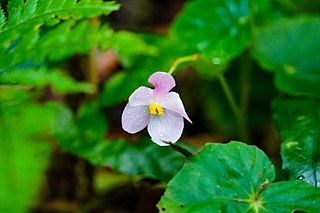
Begonia formosana is a species of flowering plant in the family Begoniaceae, native to Taiwan and the Ryukyu Islands. It is found growing in forests in shady, moist situations at elevations from 700 to 900 m.
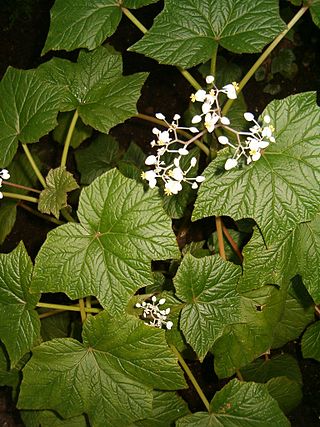
Begonia reniformis, the grape leaf begonia or grapeleaf begonia, is a species of flowering plant in the family Begoniaceae. It is native to central and eastern Brazil, and has been introduced to Hawaii. A perennial shrub with white flowers, it can reach 1.5 m (5 ft) tall.

Begonia xanthina is a species of flowering plant in the family Begoniaceae, native to the eastern Himalayas, Assam, and southwestern Yunnan in China. A rhizomatous geophyte reaching 40 cm (16 in), it is typically found growing near streams on rocky forested hills up to 800 m (2,600 ft) in elevation. It resembles Begonia rex, but with yellow flowers and scattered light green splotches on the leaves.
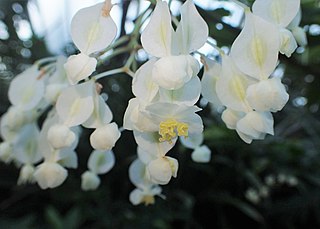
Begonia undulata, the wave leaved begonia, is a species of flowering plant in the family Begoniaceae, native to Rio de Janeiro state of Brazil. One of the more widely cultivated cane begonias, it is typically 1.8 m (6 ft) tall, but can reach 5.5 m (18 ft) if left to its own devices.
Begonia puttii is a species of flowering plant in the family Begoniaceae, native to northern Thailand. A tuberous geophyte of subtropical climes, it is in a clade with the Chinese species Begonia labordei and an unnamed Chinese species.











